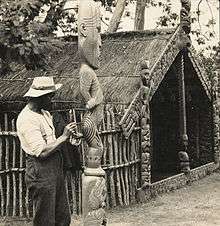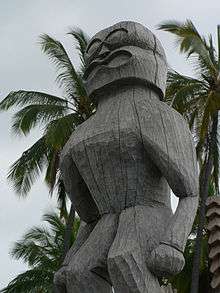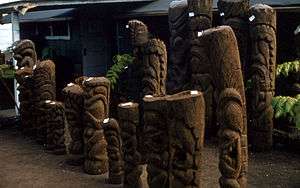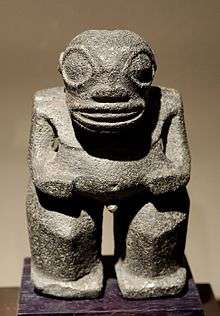Tiki
In Māori mythology, Tiki is the first man created by either Tūmatauenga or Tāne. He found the first woman, Marikoriko, in a pond; she seduced him and he became the father of Hine-kau-ataata. By extension, a tiki is a large or small wooden or stone carving in humanoid form, although this is a somewhat archaic usage in the Māori language. Carvings similar to tikis and coming to represent deified ancestors are found in most Polynesian cultures. They often serve to mark the boundaries of sacred or significant sites.


Religion
In traditions from the West Coast of the South Island of New Zealand, the first human is a woman created by Tāne, god of forests and of birds. Usually her name is Hine-ahu-one. In other legends, Tāne makes the first man Tiki, then makes a wife for him. In some West Coast versions, Tiki himself, as a son of Rangi and Papa, creates the first human by mixing his own blood with clay, and Tāne then makes the first woman. Sometimes Tūmatauenga, the war god, creates Tiki.[lower-alpha 1] In another story the first woman is Mārikoriko. Tiki marries her and their daughter is Hine-kau-ataata.[1]:151–152[lower-alpha 2] In some traditions, Tiki is the penis of Tāne.[2][3]:510–511 In fact, Tiki is strongly associated with the origin of the reproductive act.[lower-alpha 3]
In one story of Tiki among the many variants, Tiki was lonely and craved company. One day, seeing his reflection in a pool, he thought he had found a companion, and dove into the pool to seize it. The image shattered and Tiki was disappointed. He fell asleep and when he awoke he saw the reflection again. He covered the pool with earth and it gave birth to a woman. Tiki lived with her in serenity, until one day the woman was excited by an eel. Her excitement passed to Tiki and the first reproductive act resulted.[4]
Names and epithets

John White names several Tiki or perhaps manifestations of Tiki in Māori tradition:[1]:142
- Tiki-tohua, the progenitor of birds[lower-alpha 4]
- Tiki-kapakapa, the progenitor of fish and of a bird, the tui[lower-alpha 5]
- Tiki-auaha, the progenitor of humanity
- Tiki-whakaeaea, the progenitor of the kūmara.
Elsewhere in Polynesia
The word appears as tiki in New Zealand Māori, Cook Islands Māori, Tuamotuan, and Marquesan; as tiʻi in Tahitian, and as kiʻi in Hawaiian. The word has not been recorded from the languages of Western Polynesia or in the Rapa Nui language.[7]
- In Hawaiian traditions the first man was Kumuhonua. He was made by Kāne, or by Kāne, Kū, and Lono. His body was made by mixing red earth with saliva. He was made in the shape of Kāne, who carried the earth from which the man was made from the four corners of the world. A woman was made from one of his ribs[3]:511 Kanaloa was watching when Kāne made the first man, and he too made a man, but could not bring him to life. Kanaloa then said to Kāne, “I will take your man, and he will die.” And so death came upon mankind.[3]:151
- In Tahiti, Tiʻi was the first man, and was made from red earth. The first woman was Ivi who was made from one of the bones (ivi) of Tiʻi.[3]:151
- In the Marquesas Islands, there are various accounts. In one legend Atea and his wife created people. In another tradition Atanua and her father Atea brought forth humans.[3]:151
- In the Cook Islands, traditions also vary. At Rarotonga, Tiki is the guardian of the entrance to Avaiki, the underworld. Offerings were made to him as gifts for the departing soul of someone who is dying. At Mangaia, Tiki is a woman, the sister of Veetini, the first person to die a natural death. The entrance to Avaiki (the underworld) is called ‘the chasm of Tiki’.[3]:151
- According to Easter Island (Rapa Nui) legend, Hotu Matu'a, the first chief brought along a moʻai (other traditional sources mention two) symbolizing ancestors, which became the model for the large moʻai. Dr. Jo Anne van Tilburg of the Easter Island Statue Project at UCLA says that the first stone statues originated on Rapa Nui, although oral traditions do not support this. Others contend that the first statues originated in the Marquesas or the Austral Islands.
See also
| Wikimedia Commons has media related to Tiki. |
| Look up tiki in Wiktionary, the free dictionary. |
- Hei-tiki, Māori neck pendants, often called tiki
- Moai, a monolithic human figure on Easter Island, sometimes erroneously called tiki
- Tiki culture, a 20th-century decorative style used in Polynesian-themed restaurants
- Anito, similar carvings of ancestral and nature spirits in the Philippine islands
- Totem pole, artworks similar in shape and purpose from Cascadian cultures
- Chemamull, Mapuche statues
- Walt Disney's Enchanted Tiki Room, a famous Audio-Animatronic attraction in Disneyland, Magic Kingdom (Walt Disney World) and Tokyo Disneyland.
Footnotes
- Tūmatauenga, god of war, represents man, as does Tāne, whose name means 'man'.
- John White attributes this version to Ngāti Hau.[1]
- According to Reed, "it is certain that Tiki ... has a definite phallic significance."[4] However Te Rangi Hiroa (Sir Peter Buck) pointed out that such references were only found in one late and controversial source.[5]
- In this story, Tiki-tohua was an egg produced by Hine-ahu-one, a woman made by Tāne to be his wife. This egg gave rise to all the birds.[6]
- Tiki-kapakapa (born after Tiki-tohua) was a girl who later took the name Hine-a-tauira. She and Tāne had a daughter named Hine-titamauri who was given to Tiki as his wife.[6]
References
- White, John (1887–1891). The Ancient History of the Maori. Wellington: Government Printer.CS1 maint: date format (link)
- Orbell, M. (1998). The Concise Encyclopedia of Māori Myth and Legend. Christchurch: Canterbury University Press. p. 178.
- Tregear, Edward (1891). Maori-Polynesian Comparative Dictionary. Wellington, N. Z.: Lyon and Blair. ISBN 9781432664893. Retrieved 28 September 2019.
- Reed, A.W. (1963). Treasury of Maori Folklore. Wellington: A.H. & A.W. Reed. p. 52.
- Hiroa, T.R. (Sir Peter Buck) (1974) [1949]. The Coming of the Maori (Second ed.). Wellington: Whitcombe and Tombs.
- Shortland, E. (1882). Maori Religion and Mythology. London: Longman, Green. p. 22.
- "Entries for TIKI .1 [CE] Carved human image". pollex.org.nz. Retrieved 2 March 2018.
